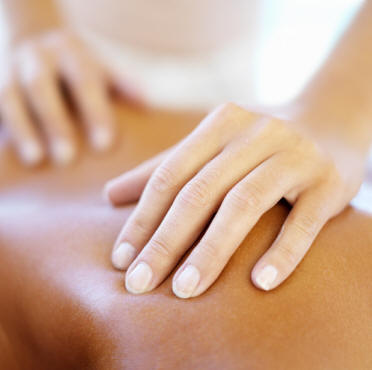Therapeutic massage has a few different meanings in the world of massage therapy. First, it is a way to indicate to the customer that the purpose of the massage is therapeutic and meant to offer health benefits. In other words, there will be no "happy endings". The other meaning of a therapeutic massage is that both the client and practitioner have a shared goal of achieving structural changes within the body, generally through a series of regular massages.
First, it is a way to indicate to the customer that the purpose of the massage is therapeutic and meant to offer health benefits. In other words, there will be no "happy endings". The other meaning of a therapeutic massage is that both the client and practitioner have a shared goal of achieving structural changes within the body, generally through a series of regular massages.
It's helpful to have a little history to understand why therapeutic massage is such an important term in the field of massage therapy. In the 1880s masseuses and masseurs worked within conventional medicine as doctors’ assistants, as well as in private practice. They were skilled in the soft tissue manipulations known as effleurage, petrissage, friction and tapotement -- the classic moves of Swedish massage -- which were developed by the European medical doctor Johann Mezger.
The Rise of The Massage Parlor
By the 1930s, Swedish massage was a whole system of physiotherapy that included soft tissue manipulation, movements, hydrotherapy and electrotherapy for general health, treating diseases and rehabilitating injuries. Masseuses and masseurs worked as physiotherapists with doctors as well as in YMCAs, public baths, spas, beauty parlors and their own health clinics, sometimes known as massage parlors.
However, "massage parlors" started opening up that provided a different service. By the 1950s and 1960s "massage parlor" was a euphemism for a place of prostitution. Massage as a legitimate therapy had fallen into disrepute, as had the professions of masseuse and masseur.
In the 1960s and 1970s a new generation of people inspired by the human potential movement and the possibility of natural healing became interested in massage therapy once again.
The Esalen Institute in California, which was established in 1962, developed its own style of Esalen massage. They called themselves massage therapists and the work they did "therapeutic massage" as a way to restoring the professional reputation of massage.
Even today male customers call independent female massage therapists to ask about their massage services, hinting that they are interested in a happy ending by asking about "whole body massage", "full release massage" or extras. By explaining that it's a therapeutic massage, the practitioner lets them know not to expect a happy ending, and will usually get off the phone quickly, refusing to book them in any event.
Therapeutic Massage To Achieve Structural Changes
The other meaning of a therapeutic massage is that both the client and practitioner have a shared goal of achieving structural changes within the body, often through a series of regular massages. While any professional massage is therapeutic, with real health benefits, some massages focus more on relaxation.
For instance, a Swedish massage is a more superficial massage that improves blood and lymph circulation and relaxes you. While it is good for your body and mind, it is not aimed at shifting the underlying structures of the body that may cause pain and restrictions.
Deep tissue massage or sports massage uses deeper pressure and cross-fiber friction in order to release tissue that is adhered or in spasm, which is certainly therapeutic. But if you get a massage in a resort setting, you probably won't see that therapist again, which limits the ongoing therapeutic benefit.
A therapeutic massage means you present to the therapist with a specific complaint, for instance, pain in your hip, tight shoulders, or a spasm in your lower back (or even all three). The therapist then follows a four steps:
- Assess your current condition. This will include taking a history, asking how long have you experienced the pain, whether the onset was sudden, how you experience the pain, etc. The therapist will also observe the way you move, test your range of motion, and feel the tissue during the treatment for consistency and texture.?You basically tell the therapist was
- Propose a plan. Once the therapist has a good idea of your condition, he can propose an approach to treatment. This might be a simple as focusing on your area of complaint -- shoulders, lower back and right hip -- instead of trying to do a full-body massage during one session. The therapist might recommend a series of sessions at recommended intervals, and indicate the kind of progress you can expect during that time. She can recommend other ways of treating the area, such as using heat, ice, hydrotherapy, or stretches. If appropriate, the therapist might refer you to another health professional for further assessment and treatment.
- Perform the therapy. This is the actual massage, or treatment, based on the assessment and the plan you have agreed to.
- Evaluate the outcome. At the end of the treatment, you and the therapist review the results. Is the pain less? Is there more mobility in the joint? Has your posture improved? On the basis of the results, the therapist can recommend additional sessions and the frequency. If you come every week, for instance, you'll see quicker progress than if you wait two or three weeks between sessions. An evaluation will take place at the end of each session to determine the continued course of therapy.
It may sound very involved, but an experienced therapist can do the assessment and propose a plan quickly, even in a resort spa, and you should experience some degree of relief even in one session. The limitation of a resort spa is that most people get a massage while on vacation. Coming back for a series of treatments is not usually practical. But you can always follow up with a private practitioner or a recommended massage therapist at a local day spa if you want to continue with therapeutic massage.
Check our Price lists for Offers


Recent Comments